2007 FIAT SEDICI warning
[x] Cancel search: warningPage 155 of 266
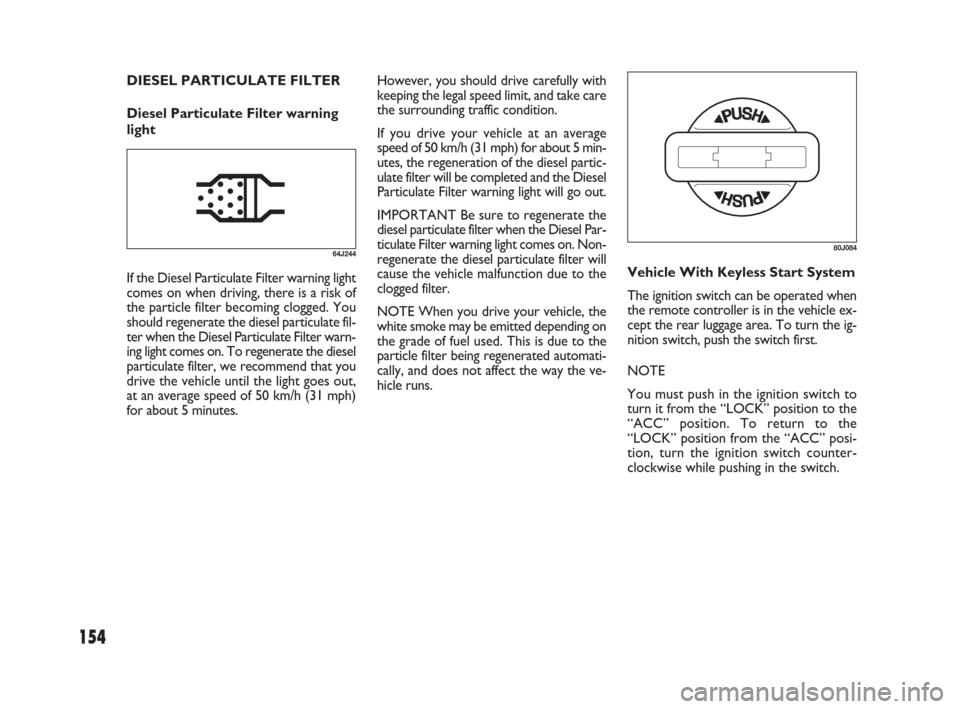
154
DIESEL PARTICULATE FILTER
Diesel Particulate Filter warning
lightHowever, you should drive carefully with
keeping the legal speed limit, and take care
the surrounding traffic condition.
If you drive your vehicle at an average
speed of 50 km/h (31 mph) for about 5 min-
utes, the regeneration of the diesel partic-
ulate filter will be completed and the Diesel
Particulate Filter warning light will go out.
IMPORTANT Be sure to regenerate the
diesel particulate filter when the Diesel Par-
ticulate Filter warning light comes on. Non-
regenerate the diesel particulate filter will
cause the vehicle malfunction due to the
clogged filter.
NOTE When you drive your vehicle, the
white smoke may be emitted depending on
the grade of fuel used. This is due to the
particle filter being regenerated automati-
cally, and does not affect the way the ve-
hicle runs.
64J244
If the Diesel Particulate Filter warning light
comes on when driving, there is a risk of
the particle filter becoming clogged. You
should regenerate the diesel particulate fil-
ter when the Diesel Particulate Filter warn-
ing light comes on. To regenerate the diesel
particulate filter, we recommend that you
drive the vehicle until the light goes out,
at an average speed of 50 km/h (31 mph)
for about 5 minutes.Vehicle With Keyless Start System
The ignition switch can be operated when
the remote controller is in the vehicle ex-
cept the rear luggage area. To turn the ig-
nition switch, push the switch first.
NOTE
You must push in the ignition switch to
turn it from the “LOCK” position to the
“ACC” position. To return to the
“LOCK” position from the “ACC” posi-
tion, turn the ignition switch counter-
clockwise while pushing in the switch.
80J084
149-166 Fiat16 New GB 27-11-2007 11:27 Pagina 154
Page 156 of 266
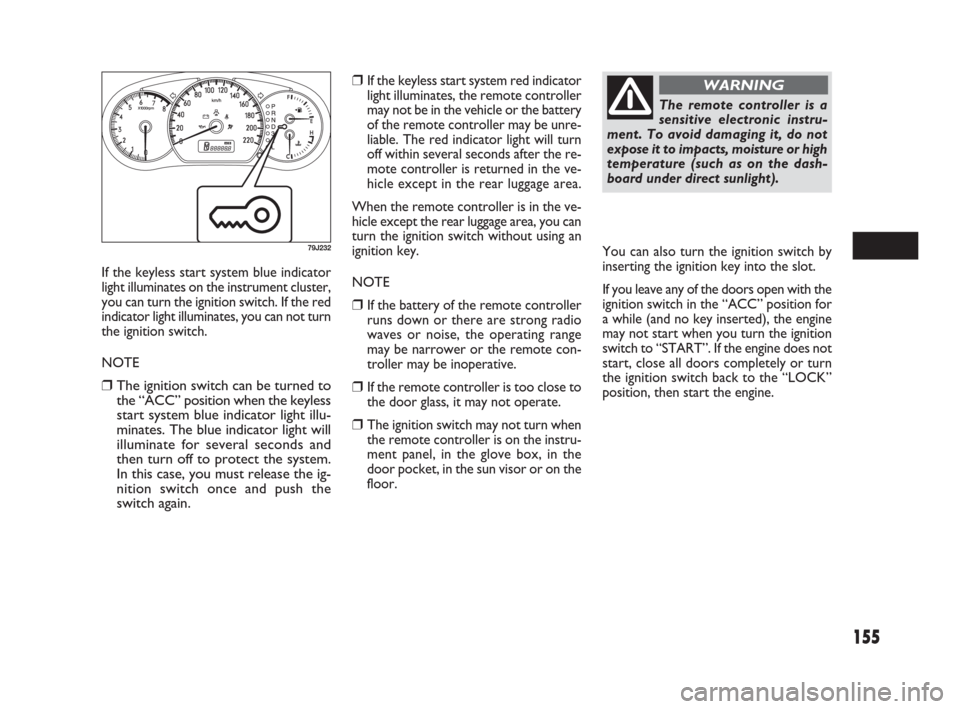
155
If the keyless start system blue indicator
light illuminates on the instrument cluster,
you can turn the ignition switch. If the red
indicator light illuminates, you can not turn
the ignition switch.
NOTE
❒The ignition switch can be turned to
the “ACC” position when the keyless
start system blue indicator light illu-
minates. The blue indicator light will
illuminate for several seconds and
then turn off to protect the system.
In this case, you must release the ig-
nition switch once and push the
switch again.
79J232
❒If the keyless start system red indicator
light illuminates, the remote controller
may not be in the vehicle or the battery
of the remote controller may be unre-
liable. The red indicator light will turn
off within several seconds after the re-
mote controller is returned in the ve-
hicle except in the rear luggage area.
When the remote controller is in the ve-
hicle except the rear luggage area, you can
turn the ignition switch without using an
ignition key.
NOTE
❒If the battery of the remote controller
runs down or there are strong radio
waves or noise, the operating range
may be narrower or the remote con-
troller may be inoperative.
❒If the remote controller is too close to
the door glass, it may not operate.
❒The ignition switch may not turn when
the remote controller is on the instru-
ment panel, in the glove box, in the
door pocket, in the sun visor or on the
floor.
The remote controller is a
sensitive electronic instru-
ment. To avoid damaging it, do not
expose it to impacts, moisture or high
temperature (such as on the dash-
board under direct sunlight).
WARNING
You can also turn the ignition switch by
inserting the ignition key into the slot.
If you leave any of the doors open with the
ignition switch in the “ACC” position for
a while (and no key inserted), the engine
may not start when you turn the ignition
switch to “START”. If the engine does not
start, close all doors completely or turn
the ignition switch back to the “LOCK”
position, then start the engine.
149-166 Fiat16 New GB 27-11-2007 11:27 Pagina 155
Page 157 of 266
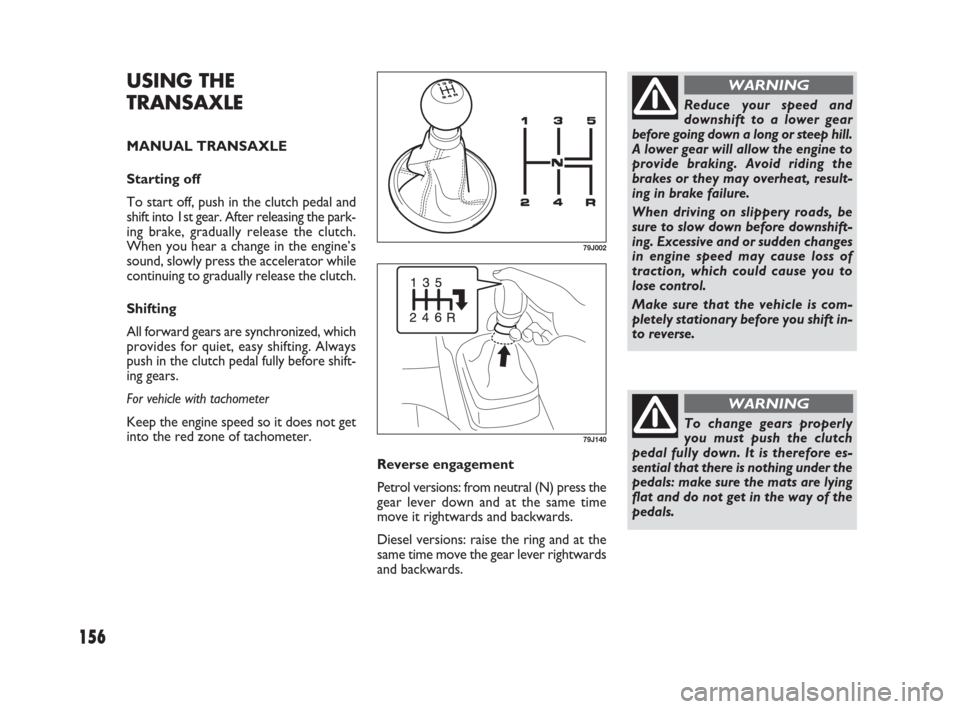
156
79J002
Reduce your speed and
downshift to a lower gear
before going down a long or steep hill.
A lower gear will allow the engine to
provide braking. Avoid riding the
brakes or they may overheat, result-
ing in brake failure.
When driving on slippery roads, be
sure to slow down before downshift-
ing. Excessive and or sudden changes
in engine speed may cause loss of
traction, which could cause you to
lose control.
Make sure that the vehicle is com-
pletely stationary before you shift in-
to reverse.
WARNING
79J140
Reverse engagement
Petrol versions: from neutral (N) press the
gear lever down and at the same time
move it rightwards and backwards.
Diesel versions: raise the ring and at the
same time move the gear lever rightwards
and backwards.
To change gears properly
you must push the clutch
pedal fully down. It is therefore es-
sential that there is nothing under the
pedals: make sure the mats are lying
flat and do not get in the way of the
pedals.
WARNING
USING THE
TRANSAXLE
MANUAL TRANSAXLE
Starting off
To start off, push in the clutch pedal and
shift into 1st gear. After releasing the park-
ing brake, gradually release the clutch.
When you hear a change in the engine’s
sound, slowly press the accelerator while
continuing to gradually release the clutch.
Shifting
All forward gears are synchronized, which
provides for quiet, easy shifting. Always
push in the clutch pedal fully before shift-
ing gears.
For vehicle with tachometer
Keep the engine speed so it does not get
into the red zone of tachometer.
149-166 Fiat16 New GB 27-11-2007 11:27 Pagina 156
Page 161 of 266
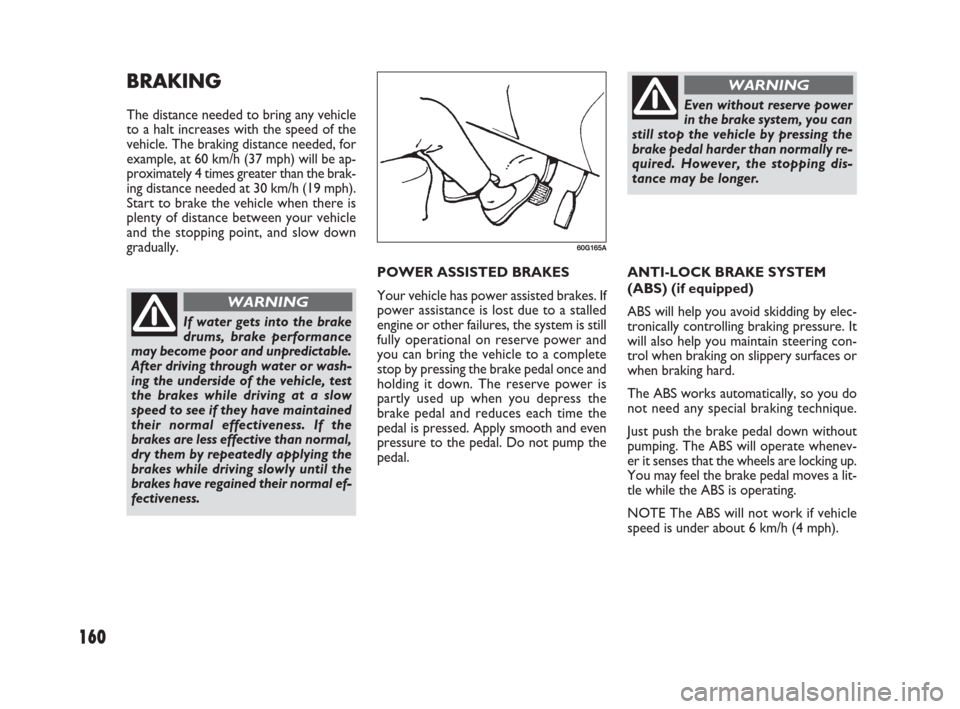
160
POWER ASSISTED BRAKES
Your vehicle has power assisted brakes. If
power assistance is lost due to a stalled
engine or other failures, the system is still
fully operational on reserve power and
you can bring the vehicle to a complete
stop by pressing the brake pedal once and
holding it down. The reserve power is
partly used up when you depress the
brake pedal and reduces each time the
pedal is pressed. Apply smooth and even
pressure to the pedal. Do not pump the
pedal.ANTI-LOCK BRAKE SYSTEM
(ABS) (if equipped)
ABS will help you avoid skidding by elec-
tronically controlling braking pressure. It
will also help you maintain steering con-
trol when braking on slippery surfaces or
when braking hard.
The ABS works automatically, so you do
not need any special braking technique.
Just push the brake pedal down without
pumping. The ABS will operate whenev-
er it senses that the wheels are locking up.
You may feel the brake pedal moves a lit-
tle while the ABS is operating.
NOTE The ABS will not work if vehicle
speed is under about 6 km/h (4 mph).
BRAKING
The distance needed to bring any vehicle
to a halt increases with the speed of the
vehicle. The braking distance needed, for
example, at 60 km/h (37 mph) will be ap-
proximately 4 times greater than the brak-
ing distance needed at 30 km/h (19 mph).
Start to brake the vehicle when there is
plenty of distance between your vehicle
and the stopping point, and slow down
gradually.
60G165A
If water gets into the brake
drums, brake performance
may become poor and unpredictable.
After driving through water or wash-
ing the underside of the vehicle, test
the brakes while driving at a slow
speed to see if they have maintained
their normal effectiveness. If the
brakes are less effective than normal,
dry them by repeatedly applying the
brakes while driving slowly until the
brakes have regained their normal ef-
fectiveness.
WARNING
Even without reserve power
in the brake system, you can
still stop the vehicle by pressing the
brake pedal harder than normally re-
quired. However, the stopping dis-
tance may be longer.
WARNING
149-166 Fiat16 New GB 27-11-2007 11:27 Pagina 160
Page 162 of 266
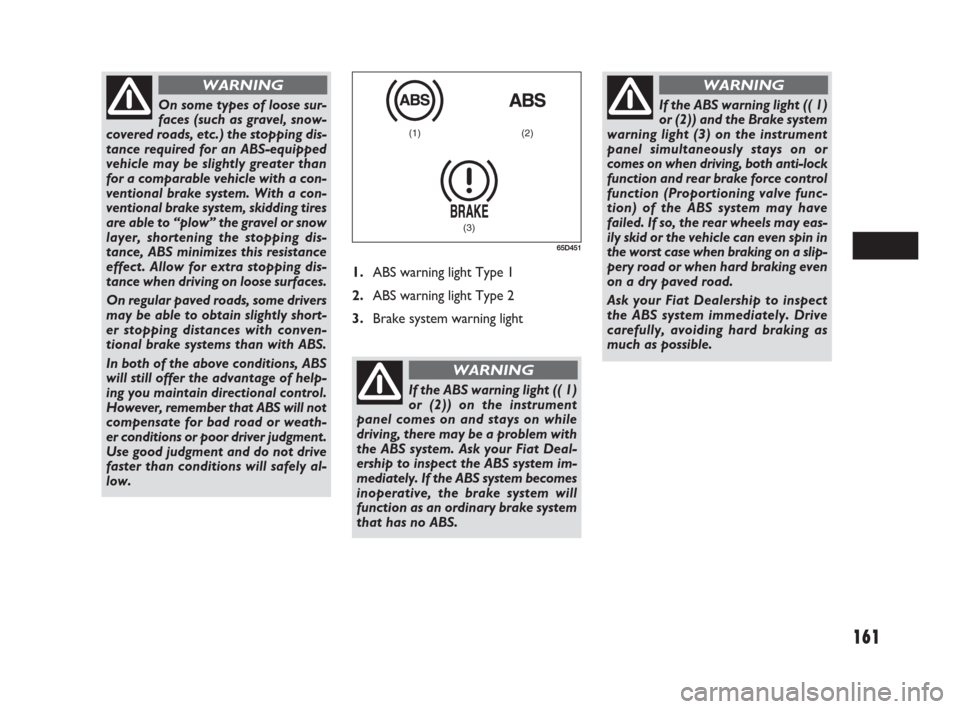
161
1.ABS warning light Type 1
2.ABS warning light Type 2
3.Brake system warning light
(1) (2)
(3)
65D451
On some types of loose sur-
faces (such as gravel, snow-
covered roads, etc.) the stopping dis-
tance required for an ABS-equipped
vehicle may be slightly greater than
for a comparable vehicle with a con-
ventional brake system. With a con-
ventional brake system, skidding tires
are able to “plow” the gravel or snow
layer, shortening the stopping dis-
tance, ABS minimizes this resistance
effect. Allow for extra stopping dis-
tance when driving on loose surfaces.
On regular paved roads, some drivers
may be able to obtain slightly short-
er stopping distances with conven-
tional brake systems than with ABS.
In both of the above conditions, ABS
will still offer the advantage of help-
ing you maintain directional control.
However, remember that ABS will not
compensate for bad road or weath-
er conditions or poor driver judgment.
Use good judgment and do not drive
faster than conditions will safely al-
low.
WARNING
If the ABS warning light (( 1)
or (2)) on the instrument
panel comes on and stays on while
driving, there may be a problem with
the ABS system. Ask your Fiat Deal-
ership to inspect the ABS system im-
mediately. If the ABS system becomes
inoperative, the brake system will
function as an ordinary brake system
that has no ABS.
WARNING
If the ABS warning light (( 1)
or (2)) and the Brake system
warning light (3) on the instrument
panel simultaneously stays on or
comes on when driving, both anti-lock
function and rear brake force control
function (Proportioning valve func-
tion) of the ABS system may have
failed. If so, the rear wheels may eas-
ily skid or the vehicle can even spin in
the worst case when braking on a slip-
pery road or when hard braking even
on a dry paved road.
Ask your Fiat Dealership to inspect
the ABS system immediately. Drive
carefully, avoiding hard braking as
much as possible.
WARNING
149-166 Fiat16 New GB 27-11-2007 11:27 Pagina 161
Page 163 of 266
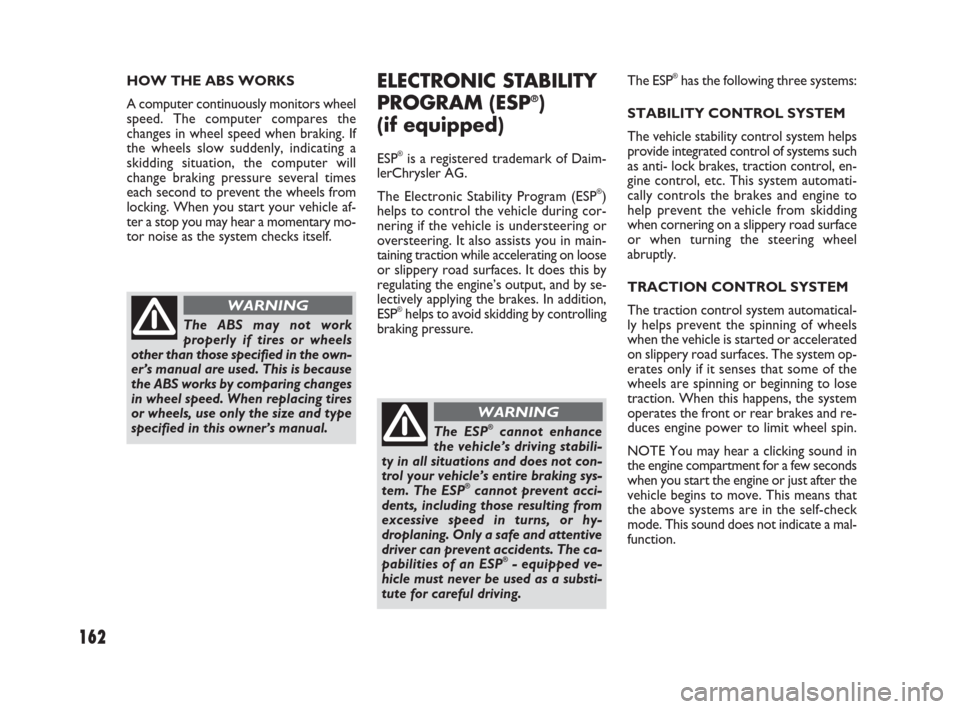
162
HOW THE ABS WORKS
A computer continuously monitors wheel
speed. The computer compares the
changes in wheel speed when braking. If
the wheels slow suddenly, indicating a
skidding situation, the computer will
change braking pressure several times
each second to prevent the wheels from
locking. When you start your vehicle af-
ter a stop you may hear a momentary mo-
tor noise as the system checks itself.
The ABS may not work
properly if tires or wheels
other than those specified in the own-
er’s manual are used. This is because
the ABS works by comparing changes
in wheel speed. When replacing tires
or wheels, use only the size and type
specified in this owner’s manual.
WARNING
ELECTRONIC STABILITY
PROGRAM (ESP®)
(if equipped)
ESP®is a registered trademark of Daim-
lerChrysler AG.
The Electronic Stability Program (ESP
®)
helps to control the vehicle during cor-
nering if the vehicle is understeering or
oversteering. It also assists you in main-
taining traction while accelerating on loose
or slippery road surfaces. It does this by
regulating the engine’s output, and by se-
lectively applying the brakes. In addition,
ESP
®helps to avoid skidding by controlling
braking pressure.
The ESP®cannot enhance
the vehicle’s driving stabili-
ty in all situations and does not con-
trol your vehicle’s entire braking sys-
tem. The ESP
®cannot prevent acci-
dents, including those resulting from
excessive speed in turns, or hy-
droplaning. Only a safe and attentive
driver can prevent accidents. The ca-
pabilities of an ESP
®- equipped ve-
hicle must never be used as a substi-
tute for careful driving.
WARNING
The ESP®has the following three systems:
STABILITY CONTROL SYSTEM
The vehicle stability control system helps
provide integrated control of systems such
as anti- lock brakes, traction control, en-
gine control, etc. This system automati-
cally controls the brakes and engine to
help prevent the vehicle from skidding
when cornering on a slippery road surface
or when turning the steering wheel
abruptly.
TRACTION CONTROL SYSTEM
The traction control system automatical-
ly helps prevent the spinning of wheels
when the vehicle is started or accelerated
on slippery road surfaces. The system op-
erates only if it senses that some of the
wheels are spinning or beginning to lose
traction. When this happens, the system
operates the front or rear brakes and re-
duces engine power to limit wheel spin.
NOTE You may hear a clicking sound in
the engine compartment for a few seconds
when you start the engine or just after the
vehicle begins to move. This means that
the above systems are in the self-check
mode. This sound does not indicate a mal-
function.
149-166 Fiat16 New GB 27-11-2007 11:27 Pagina 162
Page 164 of 266
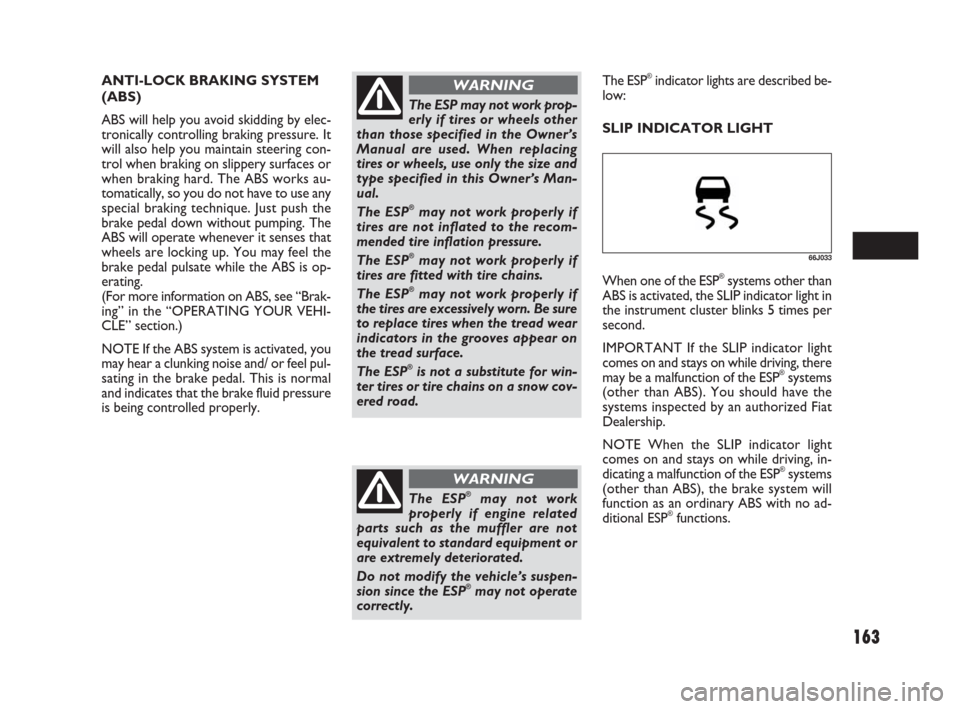
163
The ESP may not work prop-
erly if tires or wheels other
than those specified in the Owner’s
Manual are used. When replacing
tires or wheels, use only the size and
type specified in this Owner’s Man-
ual.
The ESP
®may not work properly if
tires are not inflated to the recom-
mended tire inflation pressure.
The ESP
®may not work properly if
tires are fitted with tire chains.
The ESP
®may not work properly if
the tires are excessively worn. Be sure
to replace tires when the tread wear
indicators in the grooves appear on
the tread surface.
The ESP
®is not a substitute for win-
ter tires or tire chains on a snow cov-
ered road.
WARNING
The ESP®may not work
properly if engine related
parts such as the muffler are not
equivalent to standard equipment or
are extremely deteriorated.
Do not modify the vehicle’s suspen-
sion since the ESP
®may not operate
correctly.
WARNING
ANTI-LOCK BRAKING SYSTEM
(ABS)
ABS will help you avoid skidding by elec-
tronically controlling braking pressure. It
will also help you maintain steering con-
trol when braking on slippery surfaces or
when braking hard. The ABS works au-
tomatically, so you do not have to use any
special braking technique. Just push the
brake pedal down without pumping. The
ABS will operate whenever it senses that
wheels are locking up. You may feel the
brake pedal pulsate while the ABS is op-
erating.
(For more information on ABS, see “Brak-
ing” in the “OPERATING YOUR VEHI-
CLE” section.)
NOTE If the ABS system is activated, you
may hear a clunking noise and/ or feel pul-
sating in the brake pedal. This is normal
and indicates that the brake fluid pressure
is being controlled properly.The ESP®indicator lights are described be-
low:
SLIP INDICATOR LIGHT
66J033
When one of the ESP®systems other than
ABS is activated, the SLIP indicator light in
the instrument cluster blinks 5 times per
second.
IMPORTANT If the SLIP indicator light
comes on and stays on while driving, there
may be a malfunction of the ESP
®systems
(other than ABS). You should have the
systems inspected by an authorized Fiat
Dealership.
NOTE When the SLIP indicator light
comes on and stays on while driving, in-
dicating a malfunction of the ESP
®systems
(other than ABS), the brake system will
function as an ordinary ABS with no ad-
ditional ESP
®functions.
149-166 Fiat16 New GB 27-11-2007 11:27 Pagina 163
Page 165 of 266

164
NOTE
When you disconnect and re- connect the
battery, ESP
®system functions other than
ABS will be deactivated and the slip indi-
cator light will blink 1 time per second.
In this case, use the following procedure
to reactivate the ESP
®systems:
❒Drive your vehicle straight ahead with-
out tire slippage at a speed greater than
approximately 15 km/ h (9 mph) for a
few seconds
❒The slip indicator light will go out and
the ESP®systems (other than ABS) will
be re- activated
It may take more than few seconds before
the slip indicator light goes out depending
on the road surface condition.
“ESP” Warning LightIMPORTANT If the “ESP” warning light
comes on, or stays on while driving, there
may be a malfunction of the ESP
®systems
(other than ABS). You should have the
systems inspected by an authorized Fiat
Dealership.
NOTE When the “ESP” warning light
comes on, or stays on while driving, indi-
cating a malfunction of the ESP
®systems
(other than ABS), the brake system will
function as an ordinary ABS that has no
additional ESP
®functions.
“ESP OFF” Indicator Light“ESP OFF” switch
When the “ESP OFF” switch located at
the center of the instrument panel is
pushed and held to turn off the ESP
®sys-
tems (other than ABS), the “ESP OFF” in-
dicator light in the instrument cluster
comes on.
When you have turned the ESP
®systems
(other than ABS) off, make sure to turn
them back on before resuming ordinary
driving.
When you push and hold the “ESP OFF”
switch again, the “ESP OFF” indicator light
will go out and all of the ESP
®systems will
be activated.
ABS Warning Light / Brake
System Warning Light
See “Braking” in the “OPERATING
YOUR VEHICLE” section.66J031
When the ESP®systems (other than ABS)
have a system malfunction, the “ESP”
warning light in the instrument cluster
comes on.
66J032
You should turn the ESP®on during your
ordinary driving, so that you have the ben-
efits of all of the ESP
®systems.
It may be required to turn the ESP
®sys-
tems (other than ABS) off if your vehicle
is stuck in sand, mud, or snow where
wheel spin is necessary.
62J142
149-166 Fiat16 New GB 27-11-2007 11:27 Pagina 164